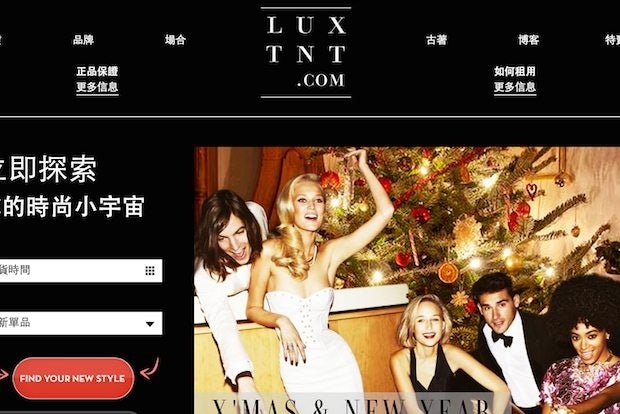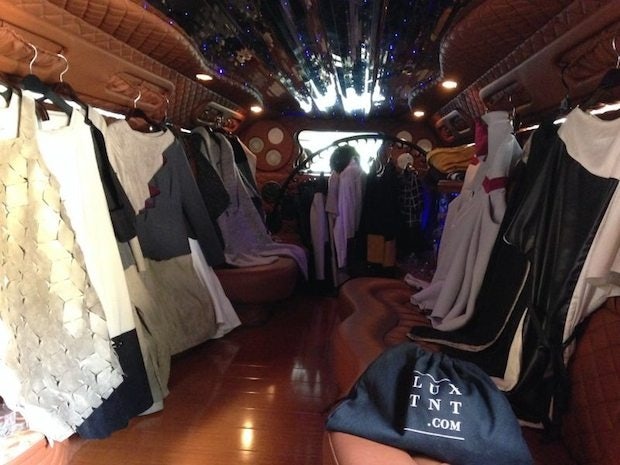
From smuggled gray-market goods to secondhand shopping, Chinese luxury consumers are constantly searching for ways to avoid China’s high tariffs. Now, China’s fashionistas on a budget have a new option that involves more selection and less worry about getting stuck with an overpriced fake: luxury rentals from LuxTNT, a new site that gives them the opportunity to pay around US$25 to carry a real $5,000 Chanel handbag or wear a $950 Alexander McQueen dress for a limited period of time.
One part Rent the Runway and one part Netflix for fashion, LuxTNT was originally launched in Hong Kong and is now in the process of expanding to Shanghai and Beijing. In addition to individual rentals for high-end fashion and accessories, the site is also rolling out a special subscription plan that will give users the chance to pay 499 RMB (around US$80) a month to create a Netflix-style queue for items and take out three pieces at a time for as long as they want.
To build up hype for its Shanghai launch, LuxTNT collaborated with Uber for a promotion on China’s Singles’ Day e-commerce holiday. Shanghai Uber users had the opportunity to hail LuxTNT’s “fashion limo” through their app, and then try on outfits available in the limo.
In order to learn more about how the site works and its prospects for mainland China, Jing Daily caught up with LuxTNT Co-Founder Bobo Rok for an interview in Beijing.

LuxTNT Co-Founder Bobo Rok with the site's sponsored Uber limo in Shanghai on China's Singles' Day. (Courtesy Photo)
Can you give us a step-by-step rundown of how the site works?#
As a customer, you come to the website and choose your style of handbag or any other accessories, and then you book the date—just like when you book a hotel. You give your credit card details, and then we do an authorized deposit. Then, someone will send it to your house within that day if your order by 12:00 or the next day if you order after 12:00. After you use the handbag for the dates you desire—two days, three days, one week, or even longer—we send people to go to the customer’s house and then pick it up. All of the deliveries and returns are completely free.
We’ve seen sites like Rent the Runway take off in the United States. Why did you think this model would be successful in China as well?#
I think the overall luxury goods industry is changing. Thirty years ago there was no fast fashion. You would buy really luxurious things and use them for decades; there wasn’t anything with style. I think fast fashion is what people want right now. You rarely see people who want to have something and wear it for a very long period over and over, again and again, and again. People want to wear different things, according to different occasions. That’s how we stepped into the China market, because the market is mature enough to have fast fashion.
How has the reception been so far for this idea?#
We started the website by approaching the socialites and celebrities in the market first because it’s luxury goods, and we wanted it to be from the top to run down to the middle class. It was really great for us to start a business with that strategy. We have all the celebrities really interested in using our business. All the OLs [office ladies] in the office were like, “What is this business?” and then they got really interested. Then, we launched our website, and got a lot of customers clicking our site. Since the day I got some of our bags back to the office, I’ve never seen them again. It was great.
You’ve opened a Shanghai office and are planning a Beijing office. How high do you think the mainland demand will be compared to Hong Kong?#
We operate in cities. I’m not going to say it’s going to be a mainland China thing—it’s going to be cities. Compared to Shanghai and Beijing, Hong Kong has fewer people. Shanghai has 20 million people and is the largest city in China. I would see the demand of Shanghai as much larger than Hong Kong, and Beijing is the same. They've got enough people to have enough demand for a business.
Can you talk about your mainland promotional activities?#
In China, we started working with celebrities at the beginning of this year. It was really great, and I have seen a lot of celebrities in China. I’m not talking about the A-list—you know, B-list, C-list celebrities. They have to attend a lot of events. Their stylist can sometimes only borrow dresses or outfits or accessories for them from designers that want to promote their own brand, so it’s not really the style they would like to wear. Sometimes, the even receive times such as a shirt with a dirty collar—it’s not that great for their experience. They love the concept of the site—they think that’s exactly what they need. We worked with some celebrities in the Beijing Film Festival.
We also had the Uber pop-up on 11/11. It was more popular than I originally would have thought because the whole of Shanghai was actually talking about it. Even when I was on my way to the airport, the taxi driver was asking me, “Have you heard about this event?”
I see people want to access luxury goods. They want to access different outfits, they have the desire to dress nicely, and then they want styling service. They want people like us to give them an opportunity to stress their personality.

Inside LuxTNT's sponsored Uber limo for its promotion in Shanghai. (Courtesy Photo)
How do you go about choosing which items get on the site? Now that you’re expanding into the mainland, will that affect the curation of the items? Will there be any items specifically for the mainland?#
Definitely. Each city will have a different buying team, and then we do our marketing research of what locals want in that market. Also, from our point of view, we have great curation that we think is suitable for the market. This makes us different—we have top fashion stylists’ tastes as well as knowledge of what local people wear, so it’s a two-sided way to create this curation.
What are the key characteristics of a typical customer?#
All of the customers are quite similar. They all want to have a certain budget—it doesn’t matter whether they’re poor or rich—they have a certain budget for their outfits and luxury goods spending, but none of them want to wear the same thing all the time. They’re the sort of girls who would like to wear different things on different occasions, but they have a certain budget to spend. For example, talking about the office ladies in Beijing: maybe their salary can’t let them buy more than one or two luxury handbags a year. If we give them the option to wear 12 different handbags a year—every month you can change one for the same price—that’s something that attracts our customers. They’re the people who want to experience and curate the luxury goods in their closet.
Chinese consumers are finding many ways to avoid high luxury prices in China right now, so do you think this site will create competition for luxury brands that are trying sell their full-price items in China?#
We actually work with all the brands. A lot of people thought we were competitors, but the brands see us as friends. Here is the easiest way to understand this dilemma: brands normally used to use magazines and traditional advertisement methods to capture their customers and acquire new ones. It would be the brand and the magazines—the magazines chose the customers based on those who were interested, and then they would purchase from the brand. The new generation is the brands and the bloggers—the bloggers make a post, customers see the post; if they like the post, they buy from the brand.
For us, the brand comes to LuxTNT, and then LuxTNT goes directly to the customers. Customers already use the luxury goods, and then the brands benefit. For us, we see ourselves as actually a new method for the brands’ marketing process. We also have a huge database that we can capture all the big data from that would not easily be available to the brands otherwise. The brands actually see value in us for marketing as well as having access to the info.